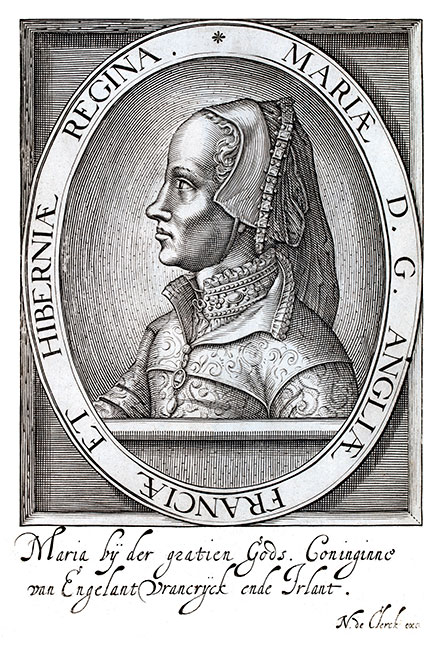Mary I, known as Mary Tudor, Queen of England
|
 |
Mary by the grace of God, Queen of England and Ireland What Wikipedia says : Mary I (18 February 1516 – 17 November 1558), also known as Mary Tudor, and as "Bloody Mary" by her Protestant opponents, was Queen of England and Ireland from July 1553 and Queen of Spain and the Habsburg dominions as the wife of King Philip II from January 1556 until her death in 1558. She is best known for her vigorous attempt to reverse the English Reformation, which had begun during the reign of her father, King Henry VIII. Her attempt to restore to the Church the property confiscated in the previous two reigns was largely thwarted by Parliament, but during her five-year reign, Mary had over 280 religious dissenters burned at the stake in the Marian persecutions. Mary was the only surviving child of Henry VIII by his first wife, Catherine of Aragon. She was declared illegitimate and barred from the line of succession following the annulment of her parents' marriage in 1533, .../... Continued on Wikipedia Engraving from a collection of 88 engravings |
Text below taken from the Biographie universelle des hommes qui se sont fait un nom by F.X. Feller. - 1860
MARY I, Queen of England, was born on 11 February 1515 to Henry VIII and Catherine of Aragon. On his death, Edward VI had declared Joan his cousin, heir to the throne, and had excluded Mary, to whom it rightfully belonged. The Duke of Northumberland, Joan's father-in-law, proclaimed her queen and raised an army to support his daughter-in-law's claim to the throne. The new queen was attached to the Catholic religion: to ensure its triumph, she married Philip II, son of Charles V, in 1554. These two spouses worked on this great project with ardent zeal, to which they believed they had to add severity. The Parliament agreed with them. It had pursued Protestants under Henry VIII,’ says Voltaire, ’encouraged them under Edward VI, and burned them under Mary. Eight hundred people were,’ says this historian, “delivered to the flames”, but we know that his hatred of the Catholic religion made him distort everything. Houced, an English author, counts only 277, and Rapin de Toiras 284. These writers are not suspect, and we cannot believe that this number is exaggerated. Cardinal Polus, sent by Pope Julius III to reunite England with the Roman Church, strongly disapproved of these executions. This prelate rightly said that the only way to extinguish heresy was to edify heretics, not to slit their throats. But Henry VIII and Edward had embittered Catholics by flooding England with their blood, and this example became fatal to the supporters of schism and heresy. Mary's character, moreover, contrasted with violent means, and more than once she was seen to oppose the arrogance of her fiercest enemies with a supple and gentle reason. Marie helped Philip her husband against France; her fleet decided the victory of Gravelines, preceded by the complete defeat of the French at Saint-Quentin; but Calais was taken from her by the Duke of Guise, and the fleet she sent arrived only to see the French flags raised in the port. She was preparing a second fleet of 120 ships when she died on 16 November 1558. Her zeal for religion was not sufficiently enlightened, but she had excellent qualities, pure morals and solid virtues: luxury and vice were banished from her court. Mr Linguet, in a very poor continuation of Hardoin's Histoire Universelle, paints Mary with dreadful colours, while he lavishes praise on Elizabeth, who flooded England with the blood of Catholics. Such is the justice of the philosophical balance. The rigours exercised against sectarians are abominable crimes; but the massacre of Catholics makes heroes. |
![]()
Copyright registration against any commercial use
of photographs, texts and/or reproductions published on this site
See explanations on "Home" page
| Site Map | Research | Links |